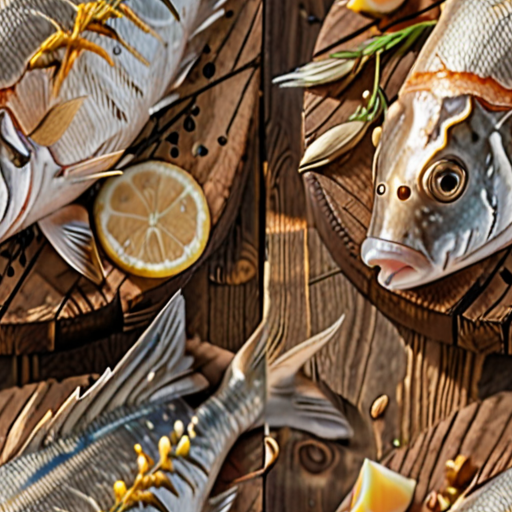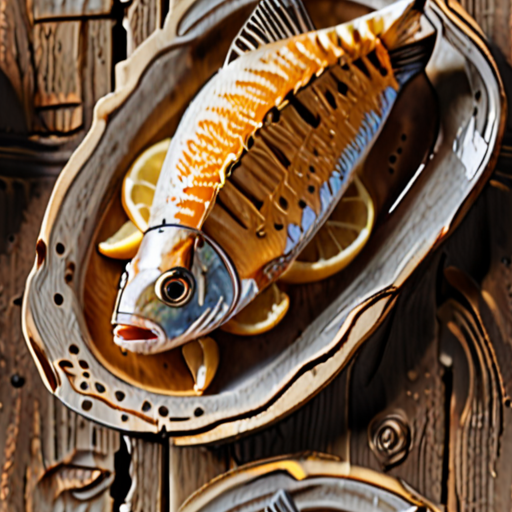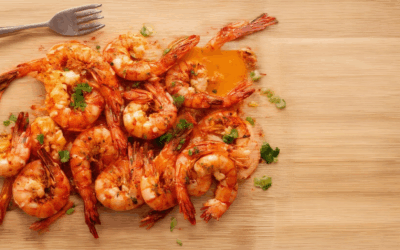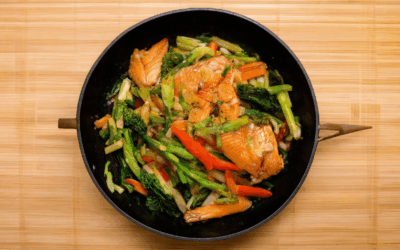Discover the art of perfectly baking fish in your oven with our comprehensive guide. Whether you’re a seasoned home cook or new to the kitchen, oven-baked fish offers a delicious and convenient way to enjoy fresh seafood. From determining the ideal temperature and cooking time to mastering the perfect seasoning, this guide provides everything you need to achieve crispy, flavorful results every time. Learn how to choose the right fish, use foils and parchments effectively, and pair your baked fish with complementary dishes. With tips and tricks tailored for both beginners and experienced cooks, this seamless cooking guide ensures your oven-baked fish turns out perfectly, impressing your family and guests alike.

How Long Does It Take to Cook Fish in the Oven?
To determine how long it takes to cook fish in the oven, consider the following steps and factors:1. **Preheat the Oven**: Begin by preheating your oven to the recommended temperature for the type of fish you’re cooking. Most fish recipes call for temperatures between 375°F (190°C) and 450°F (230°C), depending on the fish type.2. **Prepare the Fish**: Season the fish with your preferred spices or herbs. For best results, pat the fish dry with paper towels to ensure it cooks evenly.3. **Bake the Fish**: Place the fish on a baking sheet or in a baking dish. For optimal cooking, you can line the pan with parchment paper or use a non-stick cooking spray to prevent sticking.4. **Check Doneness**: The cooking time varies based on the thickness of the fish. A good rule of thumb is to bake fish for about **10 minutes per inch of thickness**. However, this can vary slightly depending on the type of fish and your desired level of doneness.5. **Use a Meat Thermometer**: Insert a meat thermometer into the thickest part of the fish to check for doneness. Fish is fully cooked when it reaches an internal temperature of 145°F (63°C). Be cautious not to overcook it, as it will become dry and flaky.### Factors Affecting Cooking Time:- **Fish Type**: Different fish have varying thicknesses and fat content, which can influence cooking time.- **Serving Size**: Larger portions will take longer to cook than smaller ones.- **Skin-On vs. Skin-Off**: Cooking fish with the skin on may require slightly less time due to the protective layer.### Example Cooking Times:- **Salmon (about 6 oz)**: 10-12 minutes- **Cod (about 8 oz)**: 8-10 minutes- **Trout (about 6 oz)**: 8-10 minutes### Tips for Perfectly Baked Fish:- **Baste with Butter or Olive Oil**: Drizzle melted butter or olive oil over the fish mid-way through cooking for extra moisture and flavor.- **Monitor Closely**: Keep an eye on the fish towards the end of the cooking time to avoid overcooking.- **Use a Le Creuset or Heavy-Bottomed Pan**: These pans retain heat better, promoting even cooking and preventing sticking.For more tips on seasoning and cooking fish, check out our guide to seasoning fish. Looking for a delicious recipe? Try our lemon garlic butter salmon. Explore more fish cooking tipsto master fish preparation in the oven.
Baking Temperature for Fish
The optimal baking temperature for fish depends on its type and thickness. Generally:- **Lean fish** like cod and tilapia are best baked around **350°F (175°C)** to prevent drying out.- **Fatty fish** such as salmon benefit from higher temperatures, around **400°F (200°C)**, to ensure even cooking and render fat.Consider the thickness of the fillet as well; thicker pieces may require slightly lower temperatures to avoid overcooking. Using a baking sheet lined with parchment paper and covering with foil can help retain moisture, especially for lean fish.
How Long Should Fish Be Cooked at 400°F?
To determine the optimal cooking time for fish at 400°F, follow these guidelines:1. **Temperature and Time**: Fish typically requires about **25 to 30 minutes** of baking at 400°F until it’s fully cooked. The exact time may vary depending on the thickness of the fillet and type of fish.2. **Doneness Check**: Insert a fork into the thickest part of the fish. If it separates easily and the fish is opaque and flaky, it’s done. Overcooking will make it dry and tough.3. **Thicker Fillets**: If you’re dealing with thicker fillets or steaks, you may need to extend the cooking time by a few minutes beyond 30.4. **General Tips**: – Season the fish generously before baking. – Arrange the fillets in a single layer on the baking sheet to ensure even cooking. – Use a baking rack to elevate the fish, allowing air circulation underneath.For best results, refer to our baking fish guidefor detailed instructions tailored to different fish types.By following these steps, you’ll achieve perfectly cooked fish every time, ensuring a moist and flavorful meal.
Baking Fish: Should It Be Covered or Uncovered?
When baking fish, the decision to cover or uncover depends on the type of fish and its fat content. Here’s a breakdown:
- Fatty Fish (e.g., Salmon): These should be covered during baking. Covering traps steam, helping to keep the fish moist and preventing it from drying out. The added moisture also enhances flavor.
- Lean Fish (e.g., Haddock): These are typically baked uncovered. Their lower fat content means they don’t need the extra moisture, and uncovering allows them to develop a crispy skin texture.
Additionally, covering fish with foil can prevent it from sticking to the pan and aid in even cooking distribution, especially for thicker fillets. However, ensure not to oversteam lean fish, as this may lead to a mushy texture.
Bake Fish on Foil or Parchment?
When baking fish, the choice between using foil or parchment paper can depend on the ingredients and your preferred outcome. Both materials are effective, but they offer distinct advantages depending on the situation.
Choosing Between Foil and Parchment
When baking fish with acidic ingredients like lemon juice or vinegar, parchment paper is often recommended. This is because acid can react with metal surfaces, causing discoloration and potential off-flavors. Parchment paper acts as a barrier, preserving the integrity of your dish while allowing steam to circulate, ensuring your fish stays tender and flavorful.
Foil is a suitable alternative when baking simpler dishes without acidic components. It conducts heat well and helps keep the fish moist. However, it can be slightly less flexible than parchment, so it may not mold as easily to the shape of the fish.
Best Practices for Baking Fish
- Parchment Paper: Ideal for dishes with lemon, vinegar, or other acidic ingredients. Place the fish skin-side down on the parchment, drizzle with oil, and fold the sides to trap steam. This method ensures your fish remains succulent and prevents sticking.
- Foil: Perfect for basic seasonings or when you prefer a crispier texture. Lightly grease the foil, place the fish on it, and bake until cooked through. Foil allows for easy cleanup and is great for simple, quick meals.
Recipe Example: Lemon-Dill Salmon Packet
For a flavorful and easy-to-make dish, try this method using parchment paper:
1. Preheat your oven to 425°F (220°C). 2. Cut a large sheet of parchment paper. Place the salmon on it, skin-side down. 3. In a small bowl, mix olive oil, lemon juice, dill, salt, and pepper. 4. Pour the mixture over the salmon and fold the parchment sides to seal. 5. Bake for 15-18 minutes, or until the salmon reaches your desired doneness. 6. Serve hot, garnished with fresh herbs.
For more seafood recipe ideas, check out our complete collection and learn how to cook fish like a pro .

Best Seasoning for Fish
Seasoning fish can greatly enhance its flavor, making meals more delicious and nutritious. Here are some of the best seasonings to use:
- Garlic and Lemon : A classic combination, garlic adds a savory touch, while lemon provides brightness and acidity.
- Dill, Parsley, and Fennel : Herbs that complement fish well, offering fresh and aromatic notes.
- Chili Flakes or Red Pepper Flakes : For those who love heat, these add a spicy kick to fish dishes.
- Salt and Pepper : Essential for balancing flavors, use sparingly to avoid overpowering the dish.
- Blackening Spice : A bold option, particularly good for grilling meats like salmon or tuna.
- Saffron : A luxurious choice, perfect for dishes like paella or risotto.
- Old Bay Seasoning : A Maryland favorite, ideal for crab cakes or fried fish.
- Herbs de Provence : A fragrant blend of rosemary, thyme, lavender, and marjoram.
The best seasoning depends on your preferences and the type of fish. Experiment with these options to find what suits your taste buds best!




0 Comments